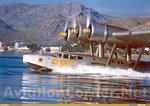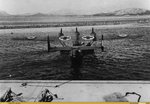After the Civil War, Franco and his staff, clearly impressed by the role air power played in their ascension to power, established the modern Spanish air force; the 'Ejercito del Aire' (EDA). Formed on October 7th, 1939, the 'Ejercito' would play a relatively small but significant part in World War II. When news of the German invasion of Red Russia reached the Spanish government, the new Fascist government's Foreign Ministry, Ramon Serrano Suñer, offered military assistance to the Nazis by way of the German Ambassador, Eberhard von Stohrer. Adolph Hitler wanted a full pledge declaration of war against the Allies, but Franco and Serrano were kindly aware that any such move will place the country's struggling economy at the mercy of Great Britain's oil embargo.
If they could not assist Germany directly, then Franco, though an all volunteer force, similar to the German-deployed Condor Legion during the Civil War, could be mustered. On July 1941, 18,000 men from all walks of life joined in what would be called the Blue Division; a ground force unit that would see heavy action in the Eastern Front. Attached to the division was a limited air expeditionary force known as the Blue Squadron or 'Escuadrilla Azul'. The Blue Squadron was part of the overall Army Group Center assets from 1941 until 1944. A total of five Spanish Squadrons flying BF-109 and later FW-190, flew a total of 1,918 sorties as part of Jagdgeschwader 51, also known as "Molders". The squadrons worked in succession beginning with the first arriving on early June 1941 until the last official one on February of 1944. They had the distinction of being the only Spanish unit to have fought in the Battle of Kursk. Its combat record consisted of 277 air kills and 74 aircraft destroyed, with a total combined loss of seven Spanish pilots.
During the first years after WWII the Spanish Air Force consisted largely of German and Italian planes and copies of them. An interesting example was the HA-1112-M1L Buchon (transliteration: "big throat"), this was essentially a licensed production of the Messerschmitt Bf 109 re-engined with a Rolls-Royce Merlin for use in Spain. Although in sheer numbers the EdA was impressive, at the end of WWII technically it had become more or less obsolete due to the progress in aviation technology during the war. For budget reasons Spain actually kept many of the old german aircraft operative well into the 50´s and 60´s, as an example the last Junkers Ju-52 transport plane was not retired from service until 1972. On March 18, 1946, the first Spanish paratroop unit was created. It participated in the Ifni War during 1957 and 1958. In this campaign many old axis aircraft still saw service such as the Junkers 52 or the Heinkel 111 (nicknamed "Pedro") and others.
If they could not assist Germany directly, then Franco, though an all volunteer force, similar to the German-deployed Condor Legion during the Civil War, could be mustered. On July 1941, 18,000 men from all walks of life joined in what would be called the Blue Division; a ground force unit that would see heavy action in the Eastern Front. Attached to the division was a limited air expeditionary force known as the Blue Squadron or 'Escuadrilla Azul'. The Blue Squadron was part of the overall Army Group Center assets from 1941 until 1944. A total of five Spanish Squadrons flying BF-109 and later FW-190, flew a total of 1,918 sorties as part of Jagdgeschwader 51, also known as "Molders". The squadrons worked in succession beginning with the first arriving on early June 1941 until the last official one on February of 1944. They had the distinction of being the only Spanish unit to have fought in the Battle of Kursk. Its combat record consisted of 277 air kills and 74 aircraft destroyed, with a total combined loss of seven Spanish pilots.
During the first years after WWII the Spanish Air Force consisted largely of German and Italian planes and copies of them. An interesting example was the HA-1112-M1L Buchon (transliteration: "big throat"), this was essentially a licensed production of the Messerschmitt Bf 109 re-engined with a Rolls-Royce Merlin for use in Spain. Although in sheer numbers the EdA was impressive, at the end of WWII technically it had become more or less obsolete due to the progress in aviation technology during the war. For budget reasons Spain actually kept many of the old german aircraft operative well into the 50´s and 60´s, as an example the last Junkers Ju-52 transport plane was not retired from service until 1972. On March 18, 1946, the first Spanish paratroop unit was created. It participated in the Ifni War during 1957 and 1958. In this campaign many old axis aircraft still saw service such as the Junkers 52 or the Heinkel 111 (nicknamed "Pedro") and others.
Last edited:




































































